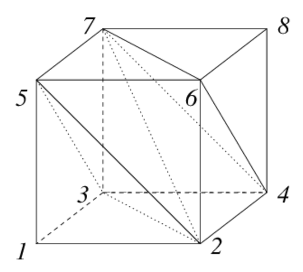The $h$-vector of the (simplicial complex dual to the) permutohedron is given by the sequence of Eulerian numbers.
Example: The (dual of the) 2-dimensional permutohedron is a hexagon, with 6 1-cells, 6 0-cells, and 1 -1-cell. So we compute the $h$-vector by $$\begin{array}{c c} (1,6,6) &= 1 \times (1,2,1)\\ & +4 \times (0,1,1) \\ &+1 \times (0,0,1) \end{array}$$ so that its $h$-vector is $(1,4,1)$.
Meanwhile the $h^*$-vector of the hypercube is also given by the Eulerian numbers. This means that the $h$-vector of a unimodular triangulation of the hypercube is the Eulerian numbers, padded with two trailing 0's.
Example: Looking at
we see that a unimodular triangulation of the cube has 6 tetrahedra, 18 triangles, 19 edges, and 8 vertices. So we compute the $h$-vector of this triangulation by $$\begin{array}{c c} (1,8,19,18,6) &= 1 \times (1,4,6,4,1)\\ & +4 \times (0,1,3,3,1) \\ &+1 \times (0,0,1,2,1) \\ &+0 \times (0,0,0,1,1) \\ &+0 \times (0,0,0,0,1) \end{array}$$ so that the $h$-vector is $(1,4,1,0,0)$.
Question: Is there some deeper geometric connection between a (unimodular) triangulation of the hypercube and the (dual to) the permuotohedron suggested by this numerology?

